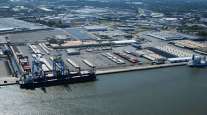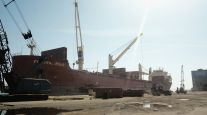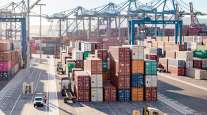Staff Reporter
White House Urges Ports to Work With Local Leaders to Secure Funding
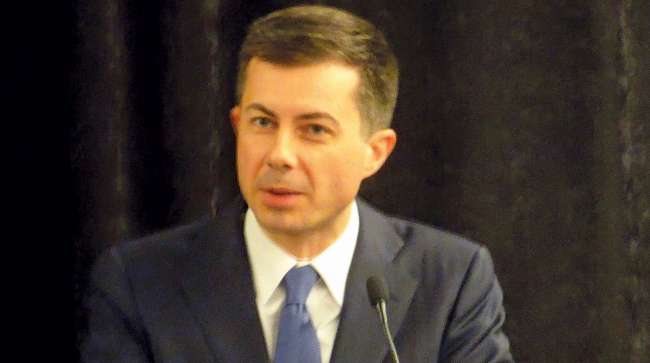
[Stay on top of transportation news: Get TTNews in your inbox.]
WASHINGTON — Top White House executives urged port leaders to collaborate with their elected leaders and focus on projects that align with Biden administration goals as they strive to access a share of $1.2 trillion in federal infrastructure funds.
“We need goods to move more smoothly,” Transportation Secretary Pete Buttigieg said during a March 29 presentation at the American Association of Port Authorities 2022 Legislative Summit. “We see opportunities with the ports in every part of the country of every size, of every kind.”
Buttigieg was joined by White House senior infrastructure coordinator Mitch Landrieu and senior adviser Ryan Berni to discuss deployment of funds from the Infrastructure Investment and Jobs Act — commonly called the Bipartisan Infrastructure Law — which President Joe Biden signed in November.
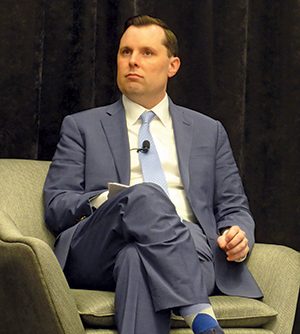
Berni (Noël Fletcher/Transport Topics)
Buttigieg noted that there is alignment between port authorities’ needs and Biden’s priorities for transportation projects reflecting safety, economic strength, climate, equity and transformation.
According to Landrieu, “There is nothing really so important to the American people than the ports and waterways. You guys are the backbone of their economy.” He advised port and shipping leaders to work closely with their governors, senators and Congressional delegations about projects to ensure ports benefit from federal infrastructure funds.
“Half the money is formula funding, which means it goes to the governors, so coordination with them is critically important,” he said. “The other half is competitive money, which means you can access it directly without going through the governors. Although, I would really encourage everybody to partner with their local elected officials to make sure you have regional cooperation on everything you’re trying to do, because it’s all tied together.”
He also stressed the importance of investments being targeted and coordinated, noting that ports are responsible for 30 million U.S. jobs and 26% of the nation’s gross domestic product. The Bipartisan Infrastructure Law directs $17 billion for ports and waterways.
“Today we announced another billion dollars through the [Army] Corps of Engineers to the rebuild locks and dams across the United States,” Landrieu said.
Berni emphasized that infrastructure projects should reflect regional cooperation with other modes, climate resilience and sustainability components, equity, and incorporation of America-made products.
“The president has been very clear on his values, by using the power of this money and power of his presidency to rebuild the industrial base of our economy,” he said, and indicated that past waivers of mandates that require the purchase of American-made products in government contracts may soon sunset. He noted that there may be exceptions, such as cranes used in container yards that require years to manufacture and are only produced overseas. Waivers of the mandates will only be made “to the extent that it’s practical,” he said.
U.S. Sen. Roger Wicker (R-Miss.) noted during an address at the event that 38 of 50 states are connected to inland waterways, facilitating over $50 billion in economic value. He said that the recent bipartisan introduction of the Ocean Shipping Reform Act of 2022 would “give the Federal Maritime Commission the tools it needs to reduce unreasonable practices by ocean carriers and try to be part of addressing supply chain issues.” He predicted that the bill could be passed unanimously, “in the blink of an eye.”
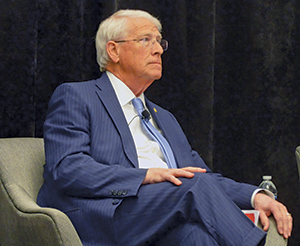
Wicker (Noël Fletcher/Transport Topics)
An afternoon panel included Jack Hedge, executive director of Utah Inland Port Authority, and Ammar Kanaan, CEO of Terminal Investment Ltd., which invests in, develops and manages container terminals around the world.
Kanaan said his Long Beach terminal only moves 29,000 boxes weekly despite a capacity for 35,000. To address bottlenecks, he stressed the need to follow a container during the entire supply chain to identify exact points when it’s not moving. He said his company has studied increasing density at container terminals “without losing one job” by having 24-hour operations and using robotics to double or triple capacity within a year.
Hedge, meanwhile, noted the importance of Utah as a truck and rail hub for West Coast ports, and backed shifting from coastal ports to offer inland distribution of goods.
Buttigieg during his panel thanked attendees for their efforts during the pandemic to deliver goods amid supply chain challenges, but acknowledged that higher shipping costs have resulted in increased pressure on prices, and consumers.
“People are feeling the pain of economic disruptions and distortions in so many ways across the country, and this administration is going to do everything we can to make life more affordable,” Buttigieg said, stressing that while the administration is “fighting inflation with everything,” the need to get infrastructure funds to the nation’s ports is urgent.
Want more news? Listen to today's daily briefing below or go here for more info:


